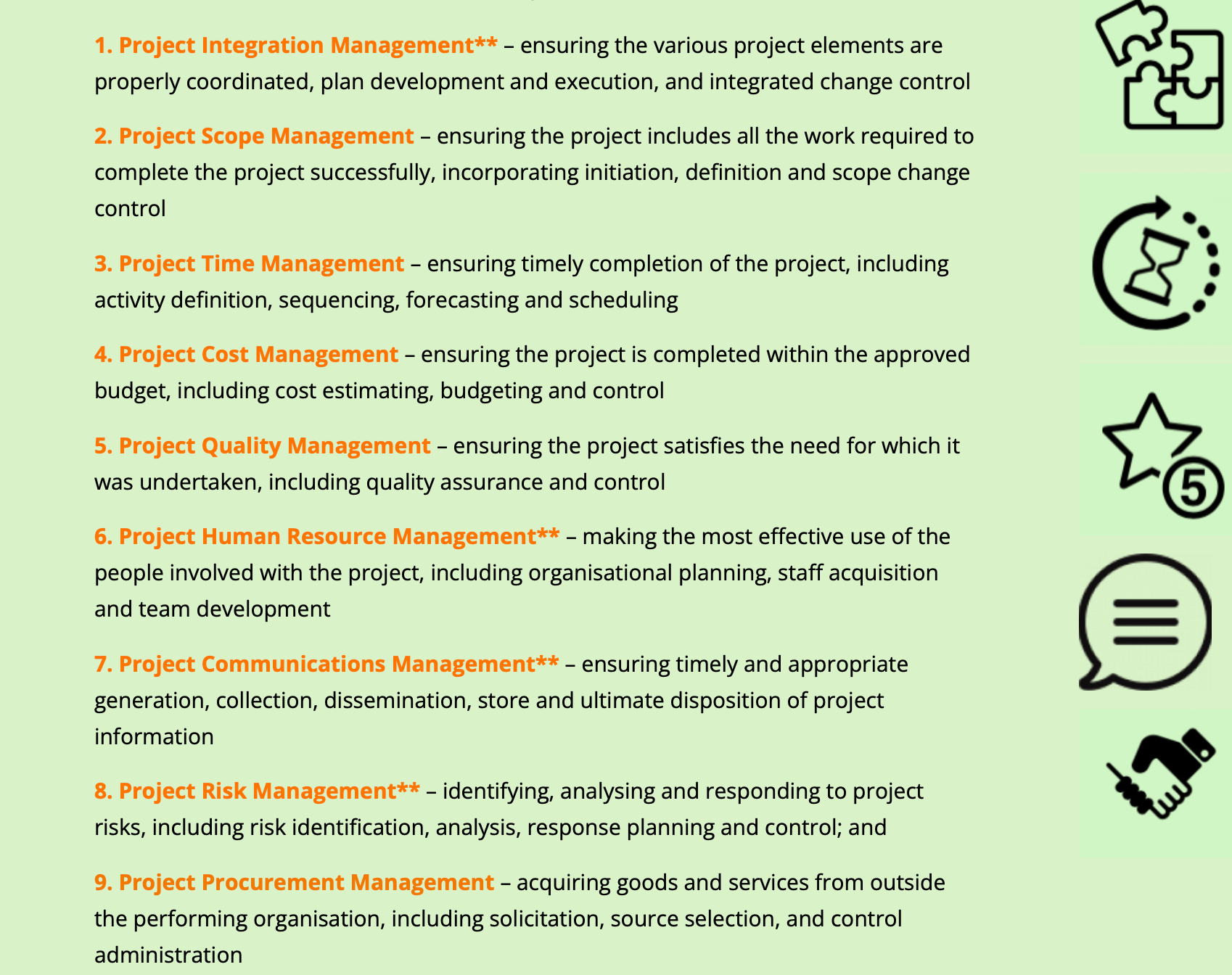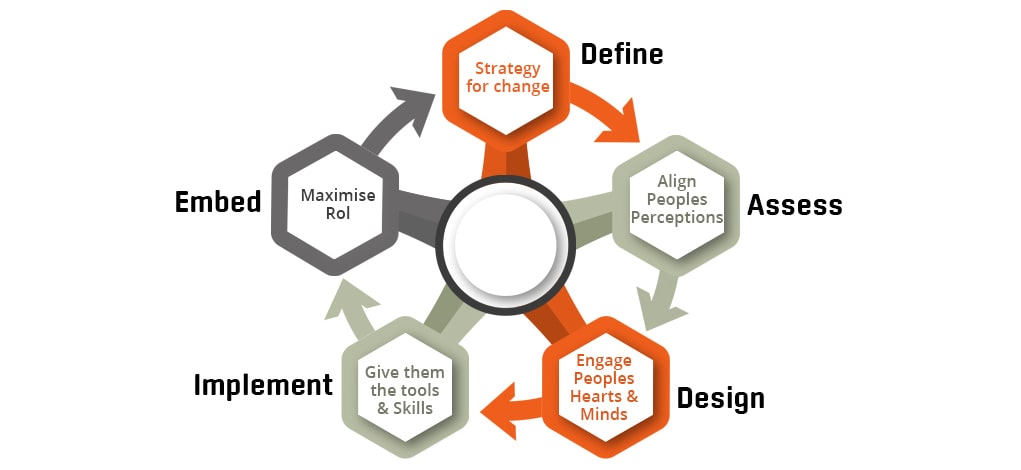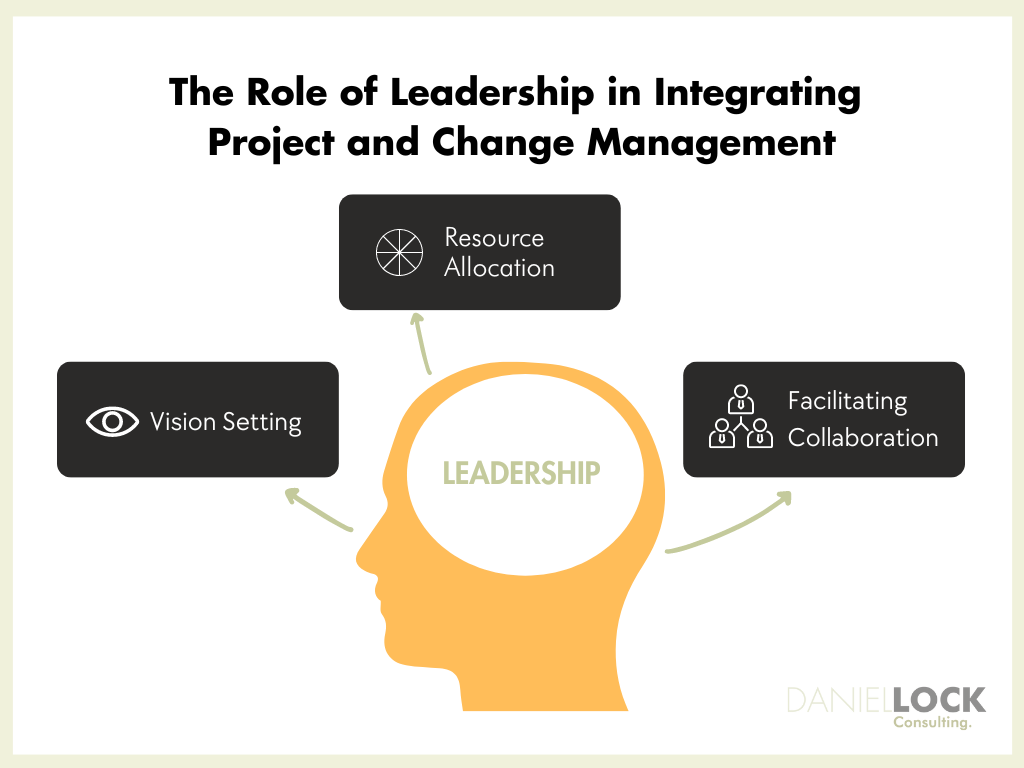The difference between change management and project management is the focus of a project manager is on implementing the technical aspects of a project or initiative. Whereas change management is focused on the people side of change, including organizational and cultural aspects.
The project manager prepares the solution for the people; the change manager prepares the people for the solution.
Project management and change management are distinct but complementary disciplines.
Project management focuses on the execution of specific tasks within defined parameters, such as time, quality, and budget, to deliver a specific outcome or product. It’s primarily concerned with the technical and logistical aspects of implementing a project.
Change management, on the other hand, focuses on the human side of change. It’s about managing the impact of change on people and helping them transition from their current state to a new one. It involves preparing, supporting, and helping individuals, teams, and organizations make organizational change.
Project management is about getting the project done right, change management is about ensuring people are ready, willing, and able for the new project. That is their able to perform in the new environment. Both are essential for the successful implementation of change in an organization.
The confusion often arises when people question, “If I have a project and change manager, why doesn’t she do the ‘people stuff’?”
The reason lies in specialization. Just as project management emerged as a distinct discipline, the best organizations have discovered that change management works better when specialized. This article will delve into the specifics of what project management and change management entail, and how they differ.
Understanding Project Management
Project management is the application of knowledge, skills, tools, and techniques to project activities in order to meet or exceed stakeholder needs and expectations from a project. It’s a discipline that ensures projects are delivered on time, within budget, and to the required quality standards.

Project Managers would be familiar with the Project Management Body of Knowledge (PMBOK), which outlines nine key knowledge areas:
1. Project Integration Management
Ensuring the various project elements are properly coordinated, plan development and execution, and integrated change control.
2. Project Scope Management
Ensuring the project includes all the work required to complete the project successfully, incorporating initiation, definition, and scope change control.
3. Project Time Management
Ensuring timely completion of the project, including activity definition, sequencing, forecasting, and scheduling.
4. Project Cost Management
Ensuring the project is completed within the approved budget, including cost estimating, budgeting, and control.
5. Project Quality Management
Ensuring the project satisfies the need for which it was undertaken, including quality assurance and control.
6. Project Human Resource Management
Making the most effective use of the people involved with the project, including organizational planning, staff acquisition, and team development.
7. Project Communications Management
Ensuring timely and appropriate generation, collection, dissemination, storage, and ultimate disposition of project information.
8. Project Risk Management
Identifying, analyzing, and responding to project risks, including risk identification, analysis, response planning, and control.
9. Project Procurement Management
Acquiring goods and services from outside the performing organization, including solicitation, source selection, and contract administration.
While project management focuses on the technical aspects of an initiative, it’s important to note that it does intersect with change management, particularly in areas like integration, human resources, communications, and risk management.
However, the primary focus of the project management team is to bring about the technical and logistical aspects of the change, leaving the organizational, people, and cultural aspects to the realm of change management, which we will explore in the next section.
Understanding Change Management
Change management is a systematic approach designed to deal with the transition or transformation of an organization’s goals, processes, or technologies. Its primary purpose is to implement strategies for effecting change, controlling change, and helping people to adapt to change.
While project management focuses on the technical aspects of an initiative, change management is concerned with the people involved. It’s about bringing individuals, teams, and organizations from the “current state” to the “future state”. In other words, it changes the course from the “default future” to the “created future”.
Change management focuses on five key areas

- Define the Change: This involves defining your change management strategy, preparing your change management team, and developing a sponsorship model. It’s about understanding who will be affected by the changes and ensuring there is strong leadership support for the change.
- Assess the Change: This phase involves creating and implementing plans to move the organization forward. This could include communication plans, training plans, and resistance management plans. It’s about engaging with employees and helping them understand why the change is necessary.
- Design the Change: This phase involves data gathering, identifying gaps and managing resistance, implementing corrective actions and celebrating successes. It’s about reinforcing the changes to ensure they stick and become part of the organization’s culture.
- Implement the change: This phase is all about implementation and transitioning end users to the future state and giving impacted people with the tools to succeed.
- Embed the change: This phase involves sustaining the change with the aim to maximize return on the investment.
Change management has a significant impact on several areas of project management, particularly those highlighted in the PMBOK such as integration, human resources, communications, and risk management. However, its focus is more on the people, business processes, and culture of an organization.
Change management activities are best integrated with the wider project plan. It’s crucial to involve the project team rather than handle the change management process as a separate stream of work. This ensures alignment of change targets, tactics, messages, and behaviors with wider project activities.
In summary, while project management brings about the technical aspects of the initiative, change management brings about the organizational, people, and cultural aspects of the change. Both are essential for a successful transformation, but they have different focuses and require different skills and approaches.
Comparing Project Management and Change Management
While project management and change management are distinct disciplines, they are closely related and often intersect in many organizations. Both are essential for driving successful change, but they have different focuses, scopes, processes, and roles.

Similarities between Project Management and Change Management
1. Shared Goal: Both the project management process and change management aim to increase the likelihood of success for an initiative or project. They both strive to meet objectives and deliver value to stakeholders.
2. Planning and Execution: Both disciplines involve careful planning, execution, and monitoring of activities to achieve desired outcomes.
3. Risk Management: Both project and change management identify and manage risks that could derail the achievement of objectives.
4. Stakeholder Engagement: Both disciplines recognize the importance of stakeholder engagement and communication in achieving project success.
Differences between Project Management and Change Management

1. Focus and Objectives: Project management is primarily concerned with the execution of a specific project within its defined scope, time, and cost constraints. It focuses on the technical aspects of the initiative. Change management, on the other hand, is concerned with the people affected by the change. It focuses on helping individuals transition from their current way of working to the new ways necessitated by the project.
2. Scope and Impact: Project management typically has a defined beginning and end and is concerned with delivering a specific output or product. Change management, however, is ongoing and deals with the broader impact of the change on the entire organization, including changes to existing processes, systems, and behaviors.
3. Processes and Tools: While both disciplines use structured approaches, the processes and tools they use are different. Project management uses tools like Gantt charts, risk logs, and project plans. Change management uses tools like stakeholder analysis, communication plans, and training plans.
4. Roles and Responsibilities: The roles and responsibilities of project managers and change managers are different. Project managers are responsible for managing the tasks required to deliver the project output. Change managers are responsible for managing the people side of the change, ensuring that the changes are understood, accepted, and adopted by the individuals affected.
In conclusion, while there are intersections and overlaps, project management and change management are distinct disciplines with different focuses. They are complementary and, when used effectively together, can significantly increase the likelihood of successful change.
The Intersection of Project Management and Change Management
While project management and change management have distinct roles and responsibilities, they are not mutually exclusive. In fact, they often intersect and complement each other in many ways. Understanding this intersection is crucial for organizations aiming to successfully implement change.
How Project Management and Change Management Complement Each Other
1. Shared Objectives: Both disciplines aim to achieve the successful implementation of a project or initiative. Project management ensures the project is completed on time, within budget, and to the required quality standards, while change management ensures that the people affected by the project are ready, willing, and able to perform their roles in the new environment.
2. Risk Mitigation: Both disciplines identify and manage risks. Project management focuses on risks related to project objectives such as scope, schedule, and cost, while change management focuses on risks related to people and their adoption of the change.
3. Stakeholder Engagement: Both disciplines recognize the importance of stakeholder engagement. Project management engages key stakeholders, to ensure the project meets its objectives, while change management engages stakeholders to ensure they are ready for the change and can work effectively in the new environment.
Related content:
The Importance of Integrating Project Management and Change Management
1. Alignment of Goals: Integrating project management and change management ensures that strategic objectives for the technical side of the change (the project) and the people side of the change (the change management) are aligned. This increases the likelihood of project success
2. Comprehensive Approach: When project management and change management processes are integrated, organizations can take a more comprehensive approach to change. This means addressing not just the technical aspects of the change, but also the human aspects, leading to more effective and sustainable change.
3. Increased Success Rate: Research shows that projects that effectively integrate project management and change management are significantly more likely to meet their objectives, stay on schedule, and stay on budget.
The Role of Leadership in Integrating Project and Change Management

1. Vision Setting: Leaders and project managers play a crucial role in setting the vision for change and aligning both project and change management efforts towards this vision.
2. Resource Allocation: Leaders of project management teams are responsible for ensuring that both project and change management teams have the necessary resources to carry out their tasks effectively.
3. Facilitating Collaboration: Leaders can foster an environment that encourages collaboration between their project teams and change management teams, helping to break down silos and promote a unified approach to change.
The Impact of Organizational Culture on Integration
1. Openness to Change: Organizations with a culture that is open to change are likely to find it easier to integrate project and change management.
2. Communication: A culture that values open and transparent communication can facilitate the integration of project and change management by promoting understanding and alignment between the two disciplines.
3. Learning Orientation: Organizations that value learning and development are more likely to invest in training and development for both project and change management, which can facilitate their integration.
In conclusion, the integration of project management and change management is not just about processes and tools, but also about leadership and culture. By fostering a culture that values collaboration, communication, and learning, organizations can more effectively integrate these two disciplines and increase their chances of successfully implementing change.
Conclusion
Recapping of the Key Differences and Similarities
Project and change management vs project, and change management are two distinct disciplines, each with its own set of objectives, focus areas, and methodologies.
While project management is primarily concerned with the execution of specific tasks within defined parameters, change management focuses on the human side of change, helping individuals and organizations transition smoothly from a current state to a desired future state.
Despite these differences, both disciplines share a common goal: to facilitate successful change and deliver value to stakeholders.
The Importance of Both Disciplines in Today’s Business Environment
In today’s rapidly changing business environment, the ability to effectively manage and adapt to change is more critical than ever. Project management provides the structure and discipline needed to execute complex tasks and deliver specific outcomes.
At the same time, change management ensures that these changes are effectively implemented and adopted at the human level. Together, these disciplines provide a comprehensive approach to managing change, reducing risk, and increasing the likelihood of successful outcomes.
Final Thoughts:
While project management and change management are distinct disciplines, they are not mutually exclusive. Instead, they are complementary and, when effectively integrated, can significantly enhance the success of organizational change and project.


